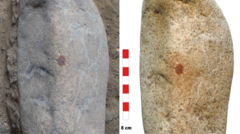Scientists from Spain have made a groundbreaking discovery, unearthing what they claim to be the oldest complete human fingerprint, which indicates that Neanderthals may have engaged in artistic expression. The finding centers on a pebble that appears to be painted with red pigment, likely from a Neanderthal individual who created a depiction of a nose on the stone approximately 43,000 years ago. This pebble was excavated from the San Lázaro rock shelter in Segovia, Spain.
According to scientists, the strategic placement of the dot on the rock signifies a considerable level of "symbolic behaviour", indicating that Neanderthals possessed the capability for abstract thinking. These findings deepen the ongoing discourse surrounding the artistic capabilities of Neanderthals, as clarified by co-author María de Andrés-Herrero during an interview with BBC.
The excavation at this site, which began five years prior, had yielded various finds, but the striking appearance of this larger stone with the red dot caught researchers' attention. Initially uncertain whether the dot was created using ochre, a natural clay pigment, researchers undertook rigorous analysis with the assistance of Spain's scientific police, which confirmed the presence of a human fingerprint on the object.
The study's findings indicated that the fingerprint belonged to an adult male; however, archaeologist David Álvarez Alonso cautioned that comparisons with other Neanderthal prints were limited, making definitive identification challenging. During a recent press briefing, Spanish official Gonzalo Santonja highlighted this pebble as the oldest painted portable object discovered in Europe and recognized it as a unique instance of Neanderthal artistry.
Prof. de Andrés-Herrero noted this research significantly contributes to understanding Neanderthals' symbolic capabilities, marking it as the first pigment-marked object found in an archaeological setting. The context of the human fingerprint further supports the notion that the dot was created for artistic purposes rather than practical use.
The prevailing theory is that a Neanderthal stumbled upon this interesting stone, with its notable fissures, and decided to leave his mark using the red ochre pigment, a substance that archeological findings suggest was purposefully brought to the site. Researchers detailed their results in the journal Archaeological and Anthropological Sciences, positing that this exceptional pebble could indeed be considered a piece of portable art within certain contexts.


















